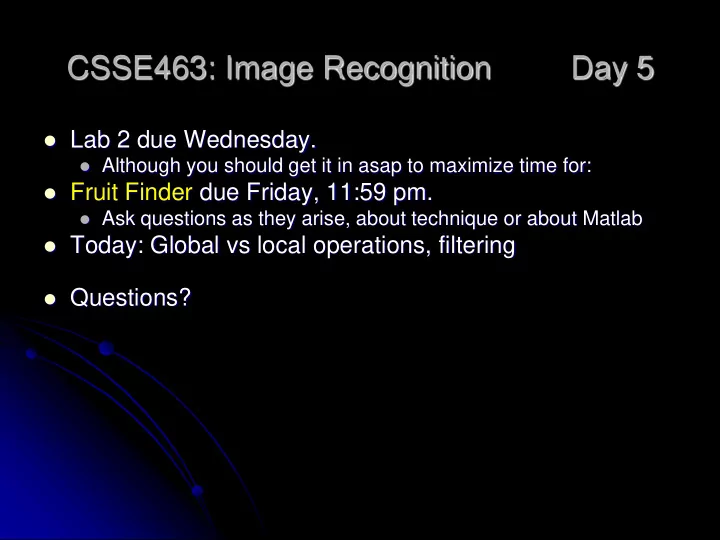

CSSE463: Image Recognition Day 5 Lab 2 due Wednesday. Although you should get it in asap to maximize time for: Fruit Finder due Friday, 11:59 pm. Ask questions as they arise, about technique or about Matlab Today: Global vs local operations, filtering Questions?
Global vs. local operators Given a pixel, p, it can be transformed to p~ using: Global operators Use information from the entire image p~ = f(p, p img) Local operators Transform each pixel based on its value or its neighborhoods ’ values only (p N includes p) p~ = f(p, p p N ) Q1
Enhancement: gray-level mapping Maps each pixel value to another value Could use a lookup table, e.g., [(0,0), (1, 3), (2, 5), …] Could use a function Identity mapping, y=x is straight line Function values above y=x are boosted, those below are suppressed. Gamma function, y = x^(1/g) (assuming x in range [0,1]) is a common a control in monitors/TVs. g=2 shown to left Effect? Q2
Gamma mappings, y = x^(1/g) Original Dark (g = 0.5) Light (g = 2) Very light (g = 4)
Histogram Equalization Creates a mapping that flattens the histogram. Uses full range [0, 255] Good: “automatically” enhances contrast where needed. Approx same level of pixels of each gray level Unpredictable results. Maintains the histogram’s shape, but changes the density of the histogram Good example of a global operation Next: pros and cons
HistEq on Sunset
HistEq on Matt
But where’s the color? Can we use gray-level mapping on color images? Discuss how Q3
Local operators The most common local operators are filters . Today: for smoothing Tomorrow: for edge detection
Image smoothing Gaussian distributions are often used to model noise in the image g = g r + N(0, ) g = sensed gray value g r = real grayvalue N(0, ) is a Gaussian (aka, N ormal, or bell curve) with mean = 0, std. dev = . Lots of Gaussian distributions in this course… Answer: average it out! 3 methods Box filter Gaussian filter Median filter Filter
Box filters Simplest. Improves homogeneous regions. Unweighted average of the pixels in a small neighborhood. For 5x5 neighborhood, 2 2 1 ( , ) ( , ) J r c I r i c j 25 i 2 j 2 See why this is a “local operation?” I = orig image, J=filtered image
Gaussian filters Nicest theoretical properties. Average weighted by distance from center pixel. Weight of pixel (i,j): 2 d 1 2 2 W ( i , j ) e 2 Then use weight in box filter formula In practice, we use a discrete approximation to W(i,j)
Median filters Averaging filters have two problems. Step edge demo They blur edges. smoothGaussDemo They don’t do well with Salt demo “salt -and- pepper” noise: smoothSaltDemo Faulty CCD elements Dust on lens Median filter: Replace each pixel with the median of the pixels in its neighborhood More expensive Harder to do with hardware But can be made somewhat efficient (Sonka, p 129) Hybrid: sigma filtering Q4,5
Discrete filters 1 / 9 1 / 9 1 / 9 Discrete 3x3 box filter: 1 / 9 1 / 9 1 / 9 To get the output at a 1 / 9 1 / 9 1 / 9 single point, take cross- correlation (basically a dot-product) of filter and image at that point To filter the whole image, shift the filter over each pixel in the original image
Recommend
More recommend